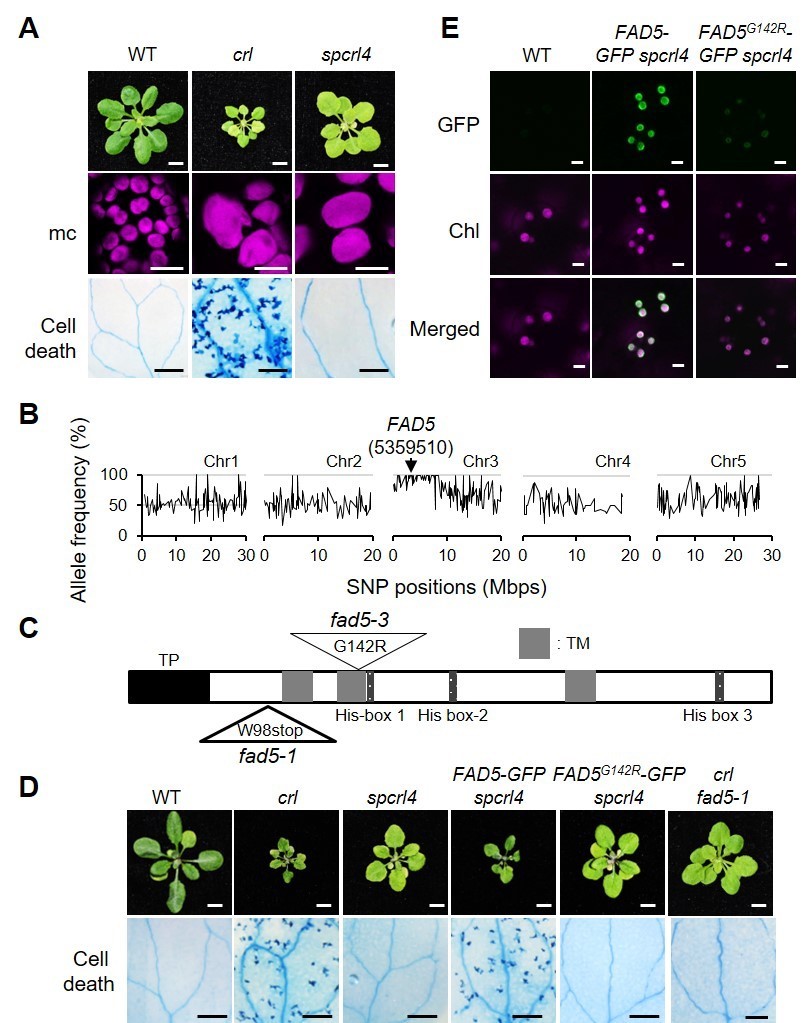Chanhong Kim研究组解析叶绿体调控植物特异性细胞死亡途径的分子机制
2004年,苏黎世联邦理工学院Klaus Apel(1942-2017)及其研究团队报道了一个重要发现:叶绿体介导的程序性细胞死亡受到叶绿体产生的单线态氧(1O2)及其传感器蛋白EXECUTER1(EX1)的调控(Wagner et al., 2004 Science)。EX1蛋白结构域的修饰或功能缺失会导致植物无法感知1O2变化,进而抑制了细胞核1O2响应基因的表达和细胞死亡的发生(Wang et al., 2016 PNAS; Dogra et al., 2019 Nat Commun),这表明叶绿体可以通过叶绿体-核的逆行信号参与细胞死亡的遗传调控。 之后,他们还在拟南芥中鉴定了叶绿体分裂缺陷突变体的独特表型(Simkova et al., 2012 Plant Journal)。这些突变体(例如crl,arc6,ftsz1-1和pdv2)具有巨大叶绿体(Gigantic Chloroplasts [GC]),并且其光合组织中表现出光依赖性局部细胞死亡。有趣的是,该表型与典型的lesion mimicking mutants (LMMs) 的表型类似。因此,之后这些突变体被大量用作揭示陆地植物细胞死亡和免疫反应的分子机制的“生物工具”。
最近,中国科学院分子植物科学卓越创新中心上海植物逆境生物学研究中心的Chanhong Kim研究组在前期研究基础上,通过反向和正向遗传学方法揭示了GC介导的细胞死亡反应的潜在机制。该研究首先通过反向遗传学方法排除了胁迫响应激素(例如SA和JA)参与GC突变体中的细胞死亡的潜在作用。之后的转录组学分析结果显示由不饱和脂肪酸的氧化产生的活性亲电物质(reactive electrophile species [RES])或脂质过氧化(lipid peroxidation)驱动的信号传导可能是引发细胞死亡的关键因子。此外,该研究发现crl的抑制子spcrl 4 (suppressor of crl 4 )在编码叶绿体定位的FAD5(Fattty Acid Desaturase 5,催化棕榈酸(16:0)转化为棕榈油酸(16:1)[图1])的核基因中存在突变。crl突变体中FAD5的丢失会导致棕榈酸相关的不饱和脂肪酸(活性氧的主要底物)水平的降低,从而减弱了RES和/或脂质过氧化的水平。 此外,fad5还抑制了其他GC突变体中免疫相关基因的表达和细胞死亡,这进一步证明了一条与FAD5依赖性自身免疫反应相关的内在逆行信号通路的存在。
该研究结果“FATTY ACID DESATURASE 5 is Required to Induce Autoimmune Responses in Gigantic Chloroplast Mutants of Arabidopsis”于2020年8月13日发表于The Plant Cell期刊。博士研究生李炳圻为该论文第一作者,Chanhong Kim研究员为该论文通讯作者。此项研究工作得到了中国科学院和国家自然科学基金的支持。
论文链接: http://www.plantcell.org/content/early/2020/08/13/tpc.20.00016

Fig. Inactivation of FAD5 Abrogates Cell Death in crl.
(A) Representative images of 21-d-old plants grown on soil under CL (Continuous Light) are shown in the top row (Bars = 0.5 cm). Confocal images of chlorophyll fluorescence in mesophyll cells (mc) in 5-d-old seedlings are shown in the middle row (Bars = 15 μm). Cell death in cotyledons (10-d-old seedlings) was visualized by TB staining and representative results are shown in the bottom row (Bars = 1 mm). (B) Whole-genome sequencing of spcrl4 in comparison with crl identified a mutation in FAD5 at position 5359510 in chromosome 3. Mbps, million base pairs. (C) A schematic illustration of FAD5 shows a transit peptide (TP, black), three transmembrane domains (TM, grey), and three His-box domains (dark grey). The mutation positions for fad5-1 and fad5-3 are indicated with triangles (W, Trp; stop, stop codon; G, Gly; R, Arg). (D) Complementation assay. Images are representative of 21-d-old plants grown on soil under CL and shown at the same scale (Bars in top row = 0.5 cm). Cell death was visualized by TB staining in the cotyledons of 10-d-old seedlings grown under CL, and a representative image from each genotype is shown (Bars in bottom row = 1 mm). (E) Subcellular localization of FAD5- GFP and FAD5G142R in 5-d-old seedlings of stable spcrl4 transgenic lines grown on soil under CL (Bars = 5 μm).